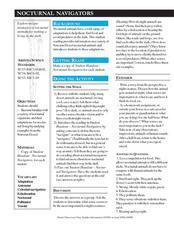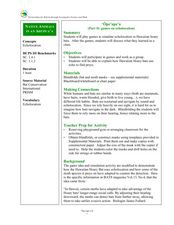Curated OER
Nocturnal vs. Diurnal Animals
First graders identify nocturnal and diurnal animals. In this animal lesson, 1st graders discuss the differences between animals that are active during the day and those that are active at night. Students write summaries about their...
Twisty Noodle
Animal Facts Book
What do your pupils know about animals? Have them put together and color this little book about animals to learn about everything from camels to pandas.
Desert Discoveries
Nocturnal Navigators
Young biologists take a look at some of the unique ways that nocturnal animals survive in the dark. After reading a terrific student handout which is embedded in the plan, learners work together to answer questions about what they have...
Curated OER
Animals Active at Night
Learners identify animals that are active at night and the reasons why. They examine the features needed to be a nocturnal animal. They create a representation of one of the animals.
Curated OER
Nocturnal Animals Cloze Activity
In this science cloze activity, 3rd graders fill in the 9 blanks in a selection about nocturnal animals. They use the words from a word bank at the bottom of the page to complete the paragraph. They cut out pictures of nocturnal animals...
Space Awareness
Day and Night in the World
How do different parts of the world experience day and night? Introduce scholars to the concept of global citizenship while teaching about animal behavior with discussion of nocturnal and diurnal animals. Then, learners complete...
Curated OER
Animal Behavior Word Search
In this animal behaviors word puzzle worksheet, students examine the 16 adjectives and names in the word bank and locate them in the word search puzzle.
Curated OER
Who Goes There?
Young scholars discover behaviors of nocturnal animals. In this animal behavior activity, students conduct a night time experiment with black light tracing materials to observe nocturnal animal behavior in the wild.
Curated OER
Games on Echolocation
Get a little batty with life science! This fun simulation game replicates how bats use echolocation to hunt moths in their native Hawaiian habitat. After creating blind folds and discussing some basic principles of echolocation, students...
Curated OER
Night Eyes
Fifth graders identify nocturnal animals based on specific characteristics. In this animals lesson, 5th graders observe an area at night using flashlights. Students record their findings and discuss as a group.
Curated OER
Where Do I Go At Night?
Students describe the requirements of daytime and nightime animals for survival. They identify any behaviors that assist in the animal surviving. They create a representation for the class to view.
Curated OER
Animal Activities: Just the tracks, ma'am
Students learn most urban mammals are nocturnal and are difficult to observe. One of the simplest ways to determine the kinds of animals living in your neighborhod is to track them down.
Curated OER
Animal Word Search
In this language arts and science worksheet, students examine a word bank with 27 animal terms. These are not specific names of animals but rather terms pertaining to animals such as "herbivore" and "nocturnal." Students find the words...
Curated OER
Animals Vocabulary List and Definitions
In this animal words worksheet, students match 15 words pertaining to animals to their definitions in another column. These definitions are related to the general animal kingdom.
Curated OER
Nocturnal Animals
In this animal worksheet, students complete a cloze activity about nocturnal animals by filling in the blanks in 2 paragraphs using 9 words from a word bank. They color and cut out 13 small pictures of nocturnal animals and paste them in...
Curated OER
Night Hike
Learners explore Upham Woods at night and investigate about the special adaptations of nocturnal animals. They identify three nocturnal animals and how they are adapted to the night. Students explain what night vision is and how it works.
Curated OER
Critters R Us or Crime Scene Critters
Students identify nocturnal animals in their local area. Using the internet, they view animal tracks to determine which ones might be in around their school. In groups, they examine outside areas and record their observations. They...
Curated OER
Guided Reading "In the Night Sky"
Students participate in a variety of reading exercises, such as choral reading and reading response journal, to reinforce concepts about space and nocturnal animals.
Curated OER
Is a bat a bird?
Provide a concise description of why a bat is not a bird by comparing their traits. This presentation defines both birds and flying mammals, explaining how they are similar and how they are different. Note: This PowerPoint is great for...
Wordpress
Darwin’s Natural Selection Case Studies
This editable worksheet is set up so that biology pupils read four case studies and identify points that are present in each, such as overproduction, heritable variation, struggle to survive, and differential reproduction. They also...
Curated OER
Technological Twins
Learners list comparisons between technology and nature. Then they create superheroes with special animal characteristics and describe how ordinary persons might replicate the changes with technology.
Curated OER
Woolybear Adaptations
In this animal adaptation worksheet, students answer three short essay questions about the adaptation of the woolybear caterpillar. This worksheet appears to be related to an unknown short film but may be completed without it.
Curated OER
Bats
Students hypothesize and model how the bones in a bat wing are made up. In this exploratory activity students test their hypothesis, develop questions about bat parts and watch a video on bats.
Curated OER
The Sharp Adaptations of Porcupines
In this porcupine learning exercise, students learn about how porcupines adapt to their lives in the woods and how they use their quills. After reading a short text and analyzing the labeled pictures, students answer 3 short answer...
Other popular searches
- Owls and Nocturnal Animals
- Preschool Nocturnal Animals
- Nocturnal Animals Lessons
- Nocturnal Animals Songs
- Poems for Nocturnal Animals
- K Nocturnal Animals
- Pre K Nocturnal Animals
- List Nocturnal Animals
- Tracks of Nocturnal Animals
- Prue K Nocturnal Animals
- Iowa Nocturnal Animals
- Nocturnal Animals Projects

























